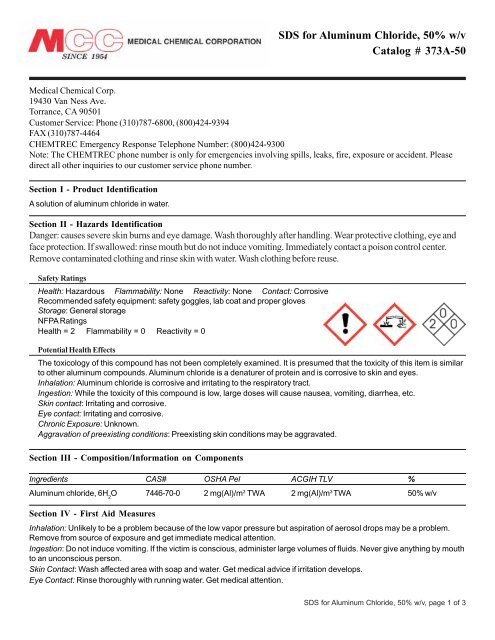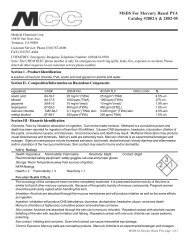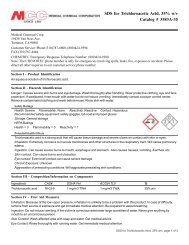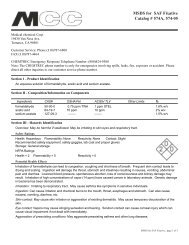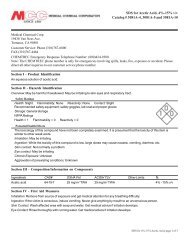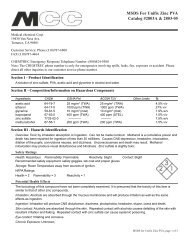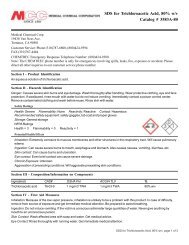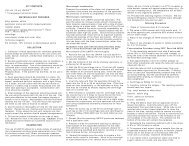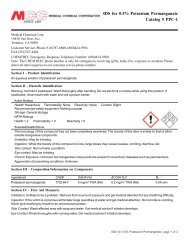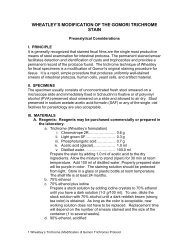SDS for Aluminum Chloride 50% w/v Catalog # 373A-50
373A-50 - Medical Chemical Corporation
373A-50 - Medical Chemical Corporation
Create successful ePaper yourself
Turn your PDF publications into a flip-book with our unique Google optimized e-Paper software.
<strong>SDS</strong> <strong>for</strong> <strong>Aluminum</strong> <strong>Chloride</strong>, <strong><strong>50</strong>%</strong> w/v<br />
<strong>Catalog</strong> # <strong>373A</strong>-<strong>50</strong><br />
Medical Chemical Corp.<br />
19430 Van Ness Ave.<br />
Torrance, CA 90<strong>50</strong>1<br />
Customer Service: Phone (310)787-6800, (800)424-9394<br />
FAX (310)787-4464<br />
CHEMTREC Emergency Response Telephone Number: (800)424-9300<br />
Note: The CHEMTREC phone number is only <strong>for</strong> emergencies involving spills, leaks, fire, exposure or accident. Please<br />
direct all other inquiries to our customer service phone number.<br />
Section I - Product Identification<br />
A solution of aluminum chloride in water.<br />
Section II - Hazards Identification<br />
Danger: causes severe skin burns and eye damage. Wash thoroughly after handling. Wear protective clothing, eye and<br />
face protection. If swallowed: rinse mouth but do not induce vomiting. Immediately contact a poison control center.<br />
Remove contaminated clothing and rinse skin with water. Wash clothing be<strong>for</strong>e reuse.<br />
Safety Ratings<br />
Health: Hazardous Flammability: None Reactivity: None Contact: Corrosive<br />
Recommended safety equipment: safety goggles, lab coat and proper gloves<br />
Storage: General storage<br />
NFPA Ratings<br />
Health = 2 Flammability = 0 Reactivity = 0<br />
Potential Health Effects<br />
The toxicology of this compound has not been completely examined. It is presumed that the toxicity of this item is similar<br />
to other aluminum compounds. <strong>Aluminum</strong> chloride is a denaturer of protein and is corrosive to skin and eyes.<br />
Inhalation: <strong>Aluminum</strong> chloride is corrosive and irritating to the respiratory tract.<br />
Ingestion: While the toxicity of this compound is low, large doses will cause nausea, vomiting, diarrhea, etc.<br />
Skin contact: Irritating and corrosive.<br />
Eye contact: Irritating and corrosive.<br />
Chronic Exposure: Unknown.<br />
Aggravation of preexisting conditions: Preexisting skin conditions may be aggravated.<br />
Section III - Composition/In<strong>for</strong>mation on Components<br />
Ingredients CAS# OSHA Pel ACGIH TLV %<br />
<strong>Aluminum</strong> chloride, 6H 2<br />
O 7446-70-0 2 mg(Al)/m 3 TWA 2 mg(Al)/m 3 TWA <strong><strong>50</strong>%</strong> w/v<br />
Section IV - First Aid Measures<br />
Inhalation: Unlikely to be a problem because of the low vapor pressure but aspiration of aerosol drops may be a problem.<br />
Remove from source of exposure and get immediate medical attention.<br />
Ingestion: Do not induce vomiting. If the victim is conscious, administer large volumes of fluids. Never give anything by mouth<br />
to an unconscious person.<br />
Skin Contact: Wash affected area with soap and water. Get medical advice if irritation develops.<br />
Eye Contact: Rinse thoroughly with running water. Get medical attention.<br />
<strong>SDS</strong> <strong>for</strong> <strong>Aluminum</strong> <strong>Chloride</strong>, <strong><strong>50</strong>%</strong> w/v, page 1 of 3
Section V - Fire Fighting Measures<br />
Flash point: Not applicable.<br />
Flammable Limits: Not applicable.<br />
Fire: Not normally a fire Hazard.<br />
Explosion: Not Normally an explosion hazards.<br />
Fire Extinguishing Media: Any means suitable <strong>for</strong> surrounding fire.<br />
Special in<strong>for</strong>mation: Pyrolysis will release corrosive aluminum oxides.<br />
Section VI - Accidental Release Measures<br />
Absorb with a suitable absorbent (such as paper towels) and store in a suitable container <strong>for</strong> disposal.<br />
Section VII - Handling and Storage<br />
Store in a closed container, protected from freezing.<br />
Section VIII - Exposure Control/Personal Protection<br />
Airborne Exposure Limits: See section III.<br />
Ventilation System: Usually not required. When required, Refer to the ACGIH document, “Industrial Ventilation, a Manual of<br />
Recommended Practices” <strong>for</strong> details about ventilation.<br />
Personal Respirator: Usually not required. In case of emergency, or when exposure levels are unknown, use a positive<br />
pressure, full face piece, air supplied respirator.<br />
Skin protection: Protective gloves are recommended as part of good laboratory practice.<br />
Eye Protection: Laboratory safety goggles or similar products are recommended as part of good laboratory practice.<br />
Section IX - Physical and Chemical Properties<br />
Boiling Point: 102 o C<br />
Density: 1.5 g/ml<br />
Vapor pressure (mm Hg): 18 @ 20 o C Evaporation Rate (water = 1): 1<br />
Vapor Density (air = 1): 0.6<br />
Solubility: Infinitely miscible with water<br />
Appearance and Odor: A clear, colorless liquid.<br />
Section X - Stability and Reactivity<br />
Stability: Freezes at low temperature.<br />
Hazardous Decomposition Products: Nothing unusual.<br />
Hazardous polymerization: Will not occur.<br />
Incompatibilities: Nothing unusual.<br />
Conditions to avoid: Excessive cold/heat and light.<br />
Section XI - Toxicological In<strong>for</strong>mation<br />
<strong>Aluminum</strong> chloride is an experimental teratogen<br />
Cancer lists<br />
Ingredient Known Carcinogenicity? Anticipated? IARC Category<br />
<strong>Aluminum</strong> chloride, hexahydrate No No None<br />
Section XII - Ecological In<strong>for</strong>mation<br />
Environmental Fate: Not biodegradable.<br />
Environmental Toxicity: None expected.<br />
Section XIII - Disposal Considerations<br />
Waste disposal is usually not restricted but local ordinances vary. Dispose of contents and container in accordance with all<br />
government regulations.<br />
<strong>SDS</strong> <strong>for</strong> <strong>Aluminum</strong> <strong>Chloride</strong>, <strong><strong>50</strong>%</strong> w/v, page 2 of 3
Section XIV - Transportation In<strong>for</strong>mation<br />
DOT/IATA Shipping name: <strong>Aluminum</strong> chloride solution Hazard Class: 8 Packing Group: III<br />
Hazard Label: Corrosive<br />
Identification Number: UN2581<br />
Bottles smaller than 32 Fl. Oz. are eligible to be shipped under ORM-D or limited quantity exemptions [49 CFR section<br />
173.154(b), 173.154(C) and IATA Y841].<br />
Section XV - Regulatory In<strong>for</strong>mation<br />
Chemical Inventory Status<br />
Ingredient TSCA EC<br />
<strong>Aluminum</strong> chloride, hexahydrate Yes Yes<br />
Federal, State and International Regulations<br />
SARA 302 SARA 313 RCRA TSCA<br />
Ingredient RQ TPQ List Category 261.33 8(D) Ca. Prop 65<br />
<strong>Aluminum</strong> chloride, hexahydrate No No No No No No No<br />
Chemical Weapons Convention: No TSCA 12(b): No CDTA: No<br />
SARA 311/312: Acute: Yes, Chronic: No, Fire: No<br />
Section XVI - Other In<strong>for</strong>mation<br />
This in<strong>for</strong>mation is believed to be correct but is not waranteed as such, nor does it purport to be all inclusive.<br />
Revision Date: Apr. 28, 2015<br />
<strong>SDS</strong> <strong>for</strong> <strong>Aluminum</strong> <strong>Chloride</strong>, <strong><strong>50</strong>%</strong> w/v, page 3 of 3


